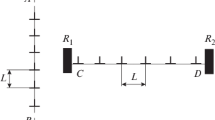Conclusions
A PM may undergo deformation through the motion of giant dislocations as well as by the usual quasiuniform mechanisms. The stress due to the resistance experienced by giant dislocations moving in the SCS is quite small, and even a slight deviation of the stressed state from omnidirectional compression is sufficient for the motion to take place.
Similar content being viewed by others
Literature cited
F. V. Lenel, “Fine-grained sintered metals and alloys,” in: Ultrafine Grain in Metals [Russian translation], Mir, Moscow (1973), pp. 90–101.
Sh. Kh. Khannanov, “Mechanism of structural superplasticity,” Fiz. Khim. Obrab. Mater., No. 3, 122–127 (1984).
L. D. Landau and E. M. Lifshitz, Theory of Elasticity, Addison-Wesley (1971).
J. Hirth and I. Lothe, Theory of Dislocations [Russian translation], Atomizdat, Moscow (1972).
Author information
Authors and Affiliations
Additional information
Translated from Poroshkovaya Metallurgiya, No. 7(283), pp. 13–16, July, 1986.
Rights and permissions
About this article
Cite this article
Khannanov, S.K. Macrodislocational mechanism of deformation of regular powder structures. Powder Metall Met Ceram 25, 541–544 (1986). https://doi.org/10.1007/BF00792355
Received:
Issue Date:
DOI: https://doi.org/10.1007/BF00792355



